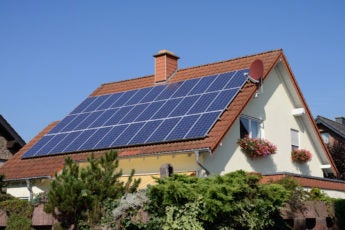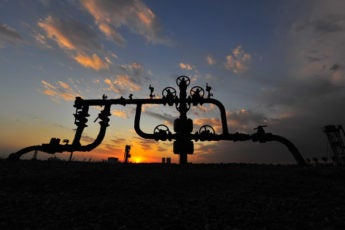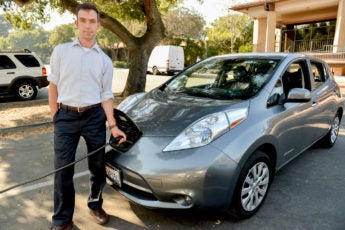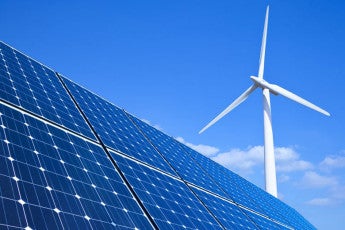Mike McGehee is now part of a thriving community working on solar technology at Stanford, but when he joined the faculty in April 2000, the field that had been vibrant in the 1970s had faded.
The only member of the engineering faculty working on solar cells, McGehee quickly recruited seven graduate students to his fledgling photovoltaics research group, but within three years, his research money had run out.
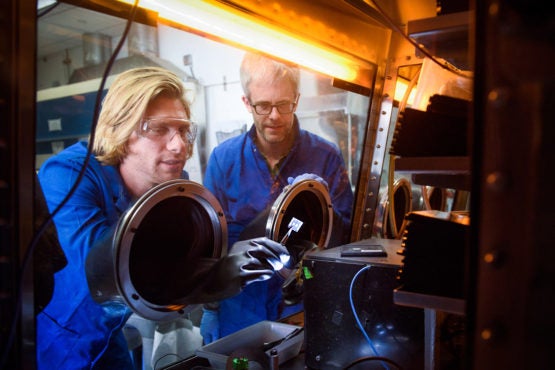
Stanford postdoctoral scholar Tomas Leijtens and Professor Mike McGehee examine perovskite tandem solar cells. (Image credit: L.A. Cicero)
“By October 2003, my startup funds were gone, and I was going to have to lay off some students,” he recalled. “I couldn’t pay them.”
Delivering the grim financial news at a group meeting, McGehee warned some students to start looking for a new faculty advisor, then returned to his office a few doors down the hall.
“I checked my computer and there it was: a congratulatory email saying I’d been awarded a $900,000 grant to study solar cells,” he said. “I ran back to the meeting room. The students were still there, and I shared the good news. There was a great celebration.”
McGehee’s $900,000 windfall came from the Global Climate and Energy Project (GCEP), a research funding program established at Stanford in 2002 in collaboration with industry as a way to spark technologies that provide energy to a growing population without contributing to greenhouse gas emissions.
For McGehee, a professor of materials science and engineering, the money couldn’t have come at a better time. “It’s very personal to me,” he said. “Without GCEP funding, I might very well have left Stanford and taken a job at a solar startup company.”
Instead, McGehee continued his photovoltaics research at Stanford and is now an internationally recognized expert on new materials for more efficient solar cells. And he’s not alone. Fifteen years later, Stanford has more than 200 faculty members with expertise on energy, from renewable technologies – like solar and wind power – to issues affecting policy and economics. Stanford also hosts more than a dozen centers and programs focused on energy research.
“GCEP was a creativity engine. We combined advances in materials science, biology, physics, chemistry, geology and engineering science with the know-how of our industrial partners,” said Sally Benson, director of GCEP and a professor of energy resources engineering in Stanford’s School of Earth, Energy & Environmental Sciences.
Energy renaissance
Like McGehee, other faculty were able to focus and even expand their research on everything from renewable technologies to carbon capture and sequestration – all with an eye to improving energy availability worldwide while moving away from fossil fuels.
“GCEP was a creativity engine.”
—Sally Benson
Director, GCEP; Co-Director, Precourt Institute for Energy
“It became clear to many of us that this sprawling energy community of scientists, engineers and other scholars needed a home, a visionary place to create more interactions and encourage collaboration,” said Lynn Orr, founding director of GCEP. “We also wanted an avenue to greater interaction beyond campus.”
That vision was fulfilled in 2009 with a large gift from alumnus Jay Precourt to establish the Precourt Institute for Energy with Orr as director. Now co-led by Benson and Arun Majumdar, a professor of mechanical engineering and of photon science, the Precourt Institute provides a focal point for campus energy programs, including a major research center on energy efficiency created in 2006, also with support from Jay Precourt.
Majumdar frames the world’s energy challenge as three big questions: “First, how do developed economies decarbonize and continue economic growth? Second, how do we provide affordable, clean energy to every human being in this world so they have a shot at their own prosperity? Third, how do we make our energy infrastructure resilient and reliable against threats, both natural and manmade?”
Parallel paths
Former U.S. Energy Secretary Steven Chu, now a professor of physics and of molecular and cellular physiology at Stanford, says that responding to climate change is going to require a significant transformation. “We have to decarbonize,” he says. “By the end of the century really, it has to be 100 percent.”
Reaching the goal of zero carbon emissions will involve many research tracks happening in parallel. The most visible is that of developing the technology to harness energy from the sun, wind, rivers and other sources. But even more challenging is the need for better technologies for storing that energy for when people need it most – when the sun isn’t shining or the wind isn’t blowing – and distributing it through a smarter electricity grid. Our homes, buildings and transportation also need to be more efficient so that more people can benefit from the energy that is produced.
Meeting the world’s increasing energy demands while slowing global warming will also require reducing carbon dioxide emissions from the fossil fuels that will continue to be an important energy source. That includes safer ways of removing fuels from the earth as well as technologies for capturing and sequestering the carbon they produce. Finally, in order to support renewable energy research and encourage its adoption, we need policies and financial strategies to incentivize business, government and citizens. These are all areas where faculty groups are working together and with external partners and governments to make progress toward a carbon-free future.
Optimistic outlook
Through collaborations at Stanford and with colleagues worldwide – as well as through the many energy companies founded by Stanford faculty – many research areas once considered high-risk and experimental are starting to pay off.
For example, clean-energy technologies – especially solar and wind power – have experienced explosive growth worldwide as prices have plummeted in recent years.
In 1975, it cost $101 to generate a single watt of electricity from a silicon solar panel. By 2016, the price had dropped as low as 35¢ per watt. The U.S. solar industry, virtually nonexistent 15 years ago, is now valued at about $30 billion and employs some 260,000 Americans. And green cars are following a similar path. Electric cars are expected to outsell their gas-fueled counterparts in some parts of the world within the next two decades.
For Mike McGehee, whose research trajectory changed so dramatically with GCEP funding, the trend is positive.
“I take the long view,” he said. “Climate change is not going away. Demand for energy globally is going up. If there are improvements in grid-scale energy storage, and if electric vehicles become significantly more popular, we could have massive growth in the solar industry for decades.”


